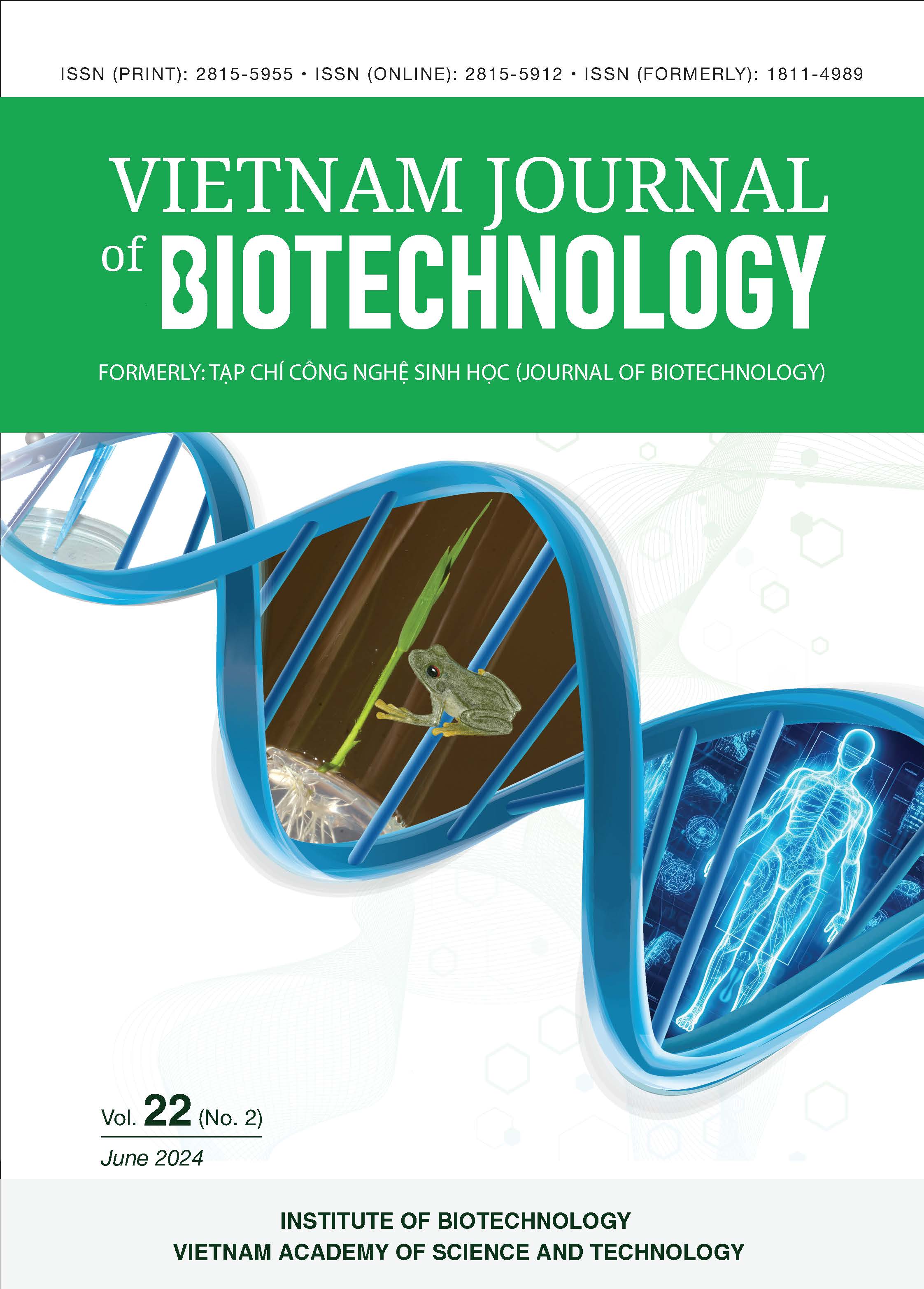Research on isolation, identification, and determination of suitable conditions for the cultivation of albino Cordyceps militaris SHBTD fruiting bodies
Author affiliations
DOI:
https://doi.org/10.15625/vjbt-21015Keywords:
Albino, cordycepin, Cordyceps militaris, mating-type (MAT) gene, fruiting bodyAbstract
Cordyceps militaris is a valuable fungus that is well-known in many Asian countries. The fruiting bodies of C. militaris are commonly used in traditional medicine and the production of functional foods. Currently, C. militaris mushrooms are being cultivated on a large scale in Vietnam, yielding the characteristic yellow-orange fruiting bodies typical of C. militaris. In the mushroom cultivation industry, C. militaris is one of the most highly valued species. The yield and quality of the fruiting bodies are greatly dependant on the strain source. Therefore, the search for new strains of C. militaris with high productivity, quality, and uniqueness is always of interest to scientists. This study has isolated and identified the albino strain C. militaris SHBTD based on morphological characteristics and the rDNA ITS region gene sequence. The optimal conditions for fruiting body formation of the SHBTD strain are MT6 medium, a temperature of 22°C, a humidity of 90%, a light intensity of 500 lux (12 hours/day), and 65 days of cultivation. Additionally, this study determined that the albino strain C. militaris SHBDT carrying the single Mating-type (MAT) gene (MAT1-1-1), could provide stable yield and quality of fruiting bodies over 5 consecutive cultivation generations. The obtained results demonstrate the potential applications of the C. militaris SHBTD in the industrial-scale production of unique and high-value mushroom products.
Downloads
References
Feng YJ, Zhu Y, Li YM, Li J, Sun YF, Shen HT, Wang AI, Lin ZP, Zhu JB (2018) Effect of strain separated parts, solid-state substrates and light condition on yield and bioactive compounds of Cordyceps militaris fruiting bodies. CyTA J Food 16(1): 916-922. https://doi.org/10.1080/19476337.2018.1498130.
Kang N, Lee HH, Park I, Seo YS (2017) Development of high cordycepin-producing Cordyceps militaris strains. Mycobiology 45(1): 31-38. https://doi.org/10.5941/myco.2017.45.1.31.
Shrestha B, Han SK, Sung JM, Sung GH (2012) Fruiting body formation of Cordyceps militaris from multi-ascospore isolates and their single ascospore progeny strains. Mycobiology 40(2): 100-106. https://doi.org/10.5941/MYCO.2012.40.2.100
Tran Van Tuan, Vu Xuan Tao (2020) Establishment of an Agrobacterium tumefaciens-mediated gene transfer approach for the medicinal fungus Cordyceps militaris G12. Vietnam Journal of Science and Technology, 62(5): 60-64.
Verma AK, Aggarwal R (2021) Repurposing potential of FDA approved and investigational drugs for COVID‐19 targeting SARS‐CoV‐2 spike and main protease and validation by machine learning algorithm. Chem Biol Drug Des 97(4); 836-853. https://doi.org/10.1111/cbdd.13812.
Vu TX., Thai HD, Dinh BHT, Nguyen HT, Tran HTP, Bui KLT, Tran TB, Pham HT, Mai LTD, Le DH, Nguyen HQ, Tran VT (2023) Effects of MAT1-2 spore ratios on fruiting body formation and degeneration in the heterothallic fungus Cordyceps militaris. J Fungi 9(10): 1-11. https://doi.org/10.3390/jof9100971.
Vu TX, Tran TB, Vu HH, Le YTH, Nguyen PH, Do TT, Nguyen TH, Tran VT (2024) Ethanolic extract from fruiting bodies of Cordyceps militaris HL8 exhibits cytotoxic activities against cancer cells, skin pathogenic yeasts, and postharvest pathogen Penicillium digitatum. Arch Microbiol 206(3): 1-11. https://doi.org/10.1007/s00203-024-03833-8.
Wang F, Liu Q, Zhang J, Liu K, Li K, Liu G, Dong C (2018) Comparative transcriptome analysis between a spontaneous albino mutant and its sibling strain of Cordyceps militaris in response to light stress. Front Microbiol 9: 1-16. https://doi.org/10.3389/fmicb.2018.01237.
White TJ, Bruns T, Lee S, Taylor JW (1990) Amplification and direct sequencing of fungal ribosomal RNA genes for phylogenetics. Innis MA, Gelfand DH, Sninsky JJ, White TJ, eds. PCR protocols: a guide to methods and applications. Academic Press, New York: 315-322. https://doi.org/10.1016/B978-0-12-372180-8.50042-1.
Xia Y, Luo F, Shang Y, Chen P, Lu Y, Wang C (2017) Fungal cordycepin biosynthesis is coupled with the production of the safeguard molecule pentostatin. Cell Chem Biol 24:1479-1489. https://doi.org/10.1016/j.chembiol.2017.09.001.
Zheng P, Xia Y, Xiao G, Xiong C, Hu X, Zhang S, Zheng H, Huang Y, Zhou Y, Wang S, Zhao GP, Liu X, Leger RJS, Wang C (2011) Genome sequence of the insect pathogenic fungus Cordyceps militaris, a valued traditional Chinese medicine. Genome Biol 12(11): 1-22. https://doi.org/10.1186/gb-2011-12-11-r116.







